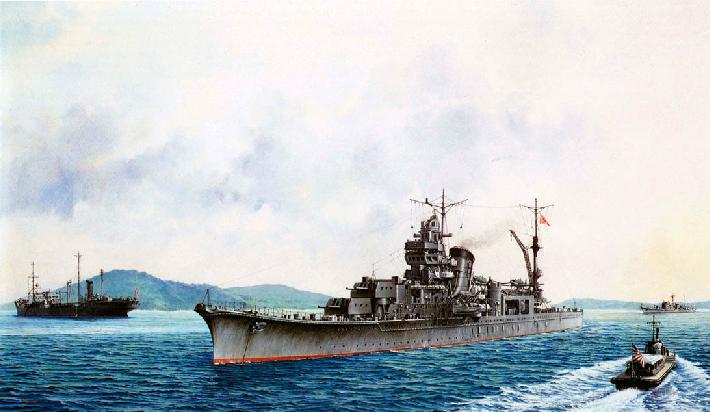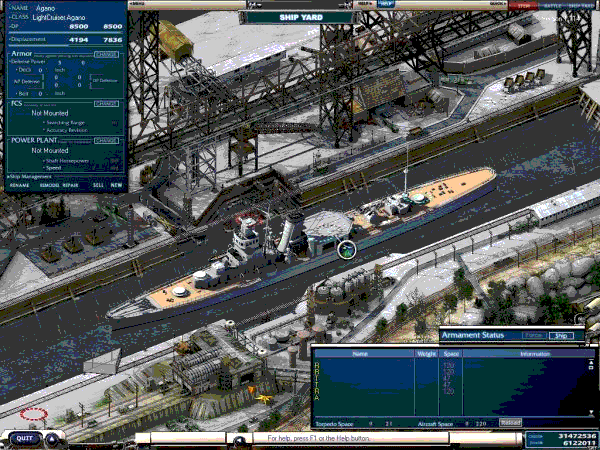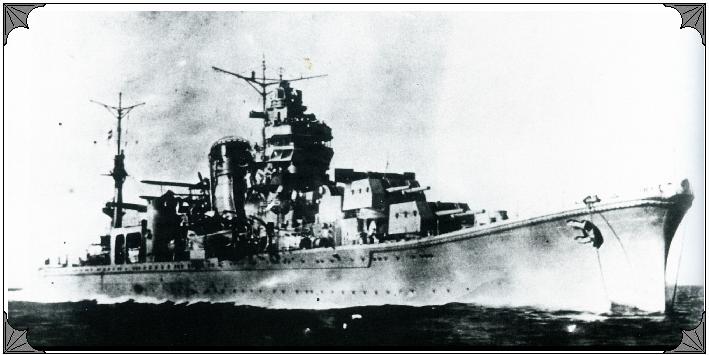

Imperial Japanese Navy - AGANO class Light Cruiser ==========================================================================
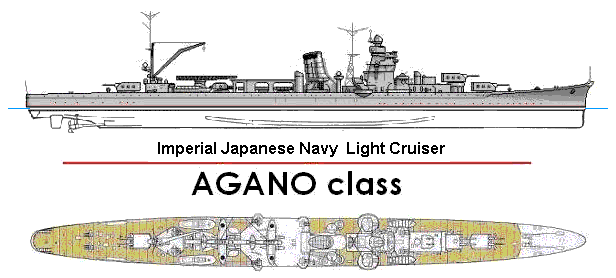
Agano was the lead ship of Agano class of four light cruisers which served with the Imperial Japanese Navy during World War II. It was named after the Agano River in Fukushima and Niigata prefectures in Japan.
The Agano class light cruisers were designed to be swift and lightly armored command vessels for destroyer or submarine squadrons, and were intended to replace earlier classes of light cruisers built soon after the end of World War I.
Four ships were laid down in the class, the Agano, Noshiro, the Yahagi, and the Sakawa. They participated in numerous actions during World War II.
Only the Sakawa survived the war, and she was used as a test subject in the Bikini Atoll atomic tests in 1946. The Yahagi was sunk by hits from bombs and torpedos while a part of the suicide run by the Yamato in April, 1945. The Agano was sunk by the American submarine Skate, while her sister ship the Noshiro was sunk during a retreat from the Battle of Samar by carrier borne aircraft.
The Imperial Japanese Navy had standardized on 5,500 ton displacement light cruisers as flagships for destroyer and submarine squadrons, and numerous vessels constructed shortly after World War I served in this role. The Agano class was conceived in the 1930s as a replacement for the now aging Tenryu, Kuma and Nagara classes. Larger than these previous light cruisers, the Agano-class vessels were fast, but with little protection, and were under-gunned for their size.
In my humble opinion, the Japanese would have done well to have emulated the Americans conversion of some of our Independence-class light cruisers into aircraft carriers, because this class (though striking looking) were pretty wimpy as cruisers: 6 x 6" guns does not exactly equate to overwhelming firepower.
Initial design specifications for the Agano class called for a nominal 5,000 ton displacement hull with six 6.1-inch (155 mm) guns and eight inch dual purpose guns. Its armor was designed to protect against 6 inch gun and vital parts had additional protections. The Agano class was unique among Japanese cruisers in that its main armament could elevate to 55 degrees, but this was still not enough to make them effective as anti-aircraft weapons.
The hull was flush-decked, and a bulbous bow was used for the first time on a Japanese warship.
The engines were a quadruple-shaft geared turbine arrangement with six boilers, developing 100.000 shp for a maximum speed of 25 knots. Like Yubari, the Agano-class had its stacks join into a single funnel.
Originally they were to have four 6.1-inch twin mounts but X turret was eliminated to allow a heavier torpedo armament and to save on costs.
As completed, the main armament was the same type of 152 mm (6 inch) gun as used on the Kongo class battlecruiser. This gun fired a 100-lb projectile 22,970 yards (21,000 m). Secondary armament consisted of four 80 mm HA, which were actually 3-inch (76.2 mm) guns in two twin mountings. These guns fired a 13.2-lb projectile and were of unique size in the Japanese navy. The design was equipped with thirty-two 25 mm AA guns. The torpedo tubes were mounted on the centerline as was more common with destroyers, and had a rapid reload system with eight spare torpedoes. The design included a single catapult forward of the main mast, with stowage for two floatplanes. Depth charge equipment was also fitted.
With the exception of the Agano, which sunk in February, 1944, all the ships received upgrades in their anti-aircraft weaponary by March, 1944, and again in July of the same year. In subsequent upgrades, the 25 mm anti-aircraft weaponry increased to 46 sets by 1944, and then to 52 sets and finally 61 sets by July 1944 on the surviving ships.
The Agano-class was followed by the larger Oyodo class, of which only one vessel was completed.
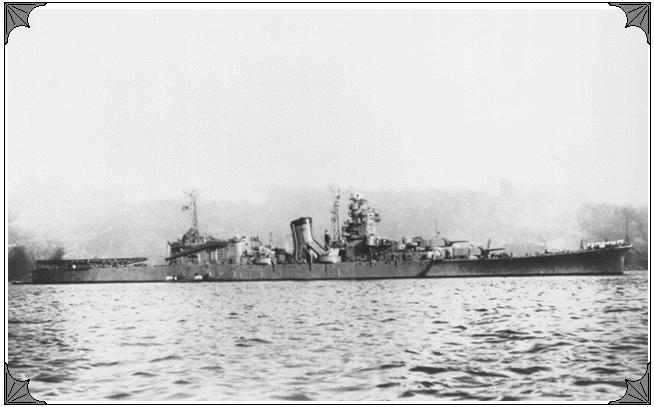
Imperial Japanese Navy - OYODO class Light Carrier ==========================================================================
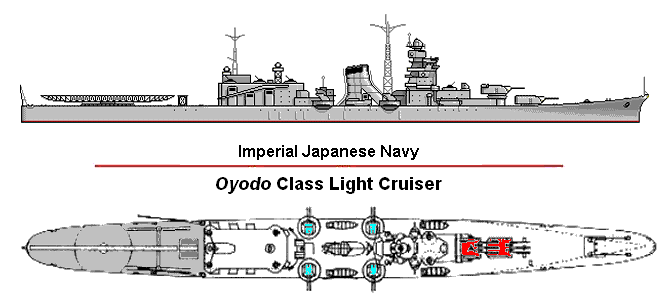
Light cruiser Ōyodo (named after the Ōyodo River in Kyūshū, Japan) was a light cruiser of the Imperial Japanese Navy, she was the first and only ship of her class.
The Ōyodo design was approved under the 1939 4th Replenishment Program as an enlarged and improved version of the Agano-class. It was designed to be the flagship for attack groups of submarines. Initially, plans were made for eight vessels in the class. However, only two ships were actually authorised, of which only one, Ōyodo, was laid down; the second ship was to be named Niyodo. However, immediately after Ōyodo was completed, all available shipbuilding resources at the Kure naval yard were diverted to build more aircraft carriers.
Therefore Oyodo was the only ship of its class, a sister (Niyodo) being cancelled before being laid down. Oyodo herself was commissioned on 28 February 1943.
Oyodo was a uniquely Japanese experiment: The Oyodo class was a light cruiser originally designed as a flagship intended to sail with a submarine squadron and provide aerial reconnaissance for scouting. She was part of the 1939 4th Replenishment Program. She had an ambitious plan with far forward main armaments and an oversized catapault which would handle six E15k reconnaisance seaplanes on her aft.
Her hull design was essentially that of an enlarged Agano-class cruiser, but she had a different armament configuration layout and had less armor. All of her primary guns were located in the forward half of the ship, so that her aft section could be freed up for operations of the up to six floatplanes that she could carry, which was vital to her design since she was to be the flagship of a scouting submarines. Because she was not to be primarily a combat ship, unlike other light cruisers in the Japanese Navy, she was not equipped with torpedo tubes.
Ōyodo's main armament comprised six 155 mm (6.1 inch) 60 caliber 3rd Year Type guns in two triple-gun turrets arranged in conventional superfiring fashion. This gun was originally developed as a dual purpose (anti-surface and anti-aircraft) weapon for the Mogami-class criuisers; when those ships underwent reconstruction in the 1930s and had their triple 155 mm turrets replaced with 203 mm (8 inch) twin turrets, the now-surplus triple 155 mm turrets were mounted on Ōyodo (as well as the Yamato-class battleships). However their slow rate of fire (5 to 6 rounds per minute) and limited elevation (up to only 55 degrees) made them somewhat unsuitable for the anti-aircraft role, but they were excellent anti-ship weapons.
The main armament was all located forward of the superstructure, much like the British Nelson-class battleships, French Dunkerque and Richelieu class and the Japanese Navy's own Tone-class heavy cruisers. Like the Tone class, the Ōyodo-class ships were intended to be scouting cruisers and hence the entire deck of the ship aft of the superstructure was devoted to aircraft facilities. Indeed, again in view of their intended role, no torpedo tubes were fitted, making the Ōyodo class the sole class of cruisers in the Imperial Japanese Navy without these weapons. The weight thus saved was invested instead in increased floatplane capacity (up to six) and a heavy-duty 45 m (148 ft) catapult that was necessary for the new E15K1 floatplane. The main armament was crowded into two triple turrets forward to leave room aft for a hangar capable of holding 4 large seaplanes, with deck stowage for two more. With the main turrets crowded forward, a separate armored box was provided for the magazines. The ship otherwise resembled an Agano.
Ōyodo's heavy anti-aircraft battery comprised eight 100 mm (3.9 inch)/65 calibre Type 98 guns in four twin mounts. These guns are the same as that carried by the Akizuki-class destroyers and the never-built B64 class cruisers. The performance of this weapon was superb, and it is considered to be the best Japanese heavy AA gun of the war. Their main fault was a rather short service life, the result of a high muzzle velocity (1,000 m/s) and a fast rate of fire (15–20 rounds per minute).
The remaining AA armament consisted of the ubiquitous (in the Japanese Navy) 25 mm/60 caliber Type 96 AA gun, which was based on a French Hotchkiss design but was a very mediocre AA weapon with a low effective rate of fire, slow elevation and training, and lack of effective remote power control.
In line with contemporary Japanese submarine tactics, the Ōyodo class was designed to be the flagship for scouting submarine flotillas. To this end, the Ōyodo class was intended to operate up to six of the upcoming high-speed Kawanishi E15K1 'Shiun' floatplanes (Allied codename 'Norm') intended to perform reconnaissance for the submarine flotilla in areas where the enemy had air superiority, and hence had to be able to take on enemy land-based fighters. To achieve this, the plane was designed with two underwing stabilizing floats that could be retracted, and a large central float that could be jettisoned, to increase performance during combat.
However, while attempting to incorporate this and several other innovations, the plane never really worked as designed and its troubled development resulted in only four aircraft entering service by 1942, and only fifteen were completed in total. Six were sent to Palau where Ōyodo was operating for operational testing. Despite a more powerful engine, the performance of the E15K1's (being about 500 kg heavier than the more common Aichi E13A1 "Jake") was poor and they were quickly lost to attacking fighters. As a result production of the aircraft, which had barely begun, was stopped and the entire E15K1 program shelved in early 1944.
Since the E15K1 'Norm' reconnaissance floatplanes turn out to not be as fast as expected and the strategic situation of the war changes before they could be delivered. It is decided instead to equip OYODO with a shorter catapult and two Aichi E16A1 'Paul' reconnaissance planes, but these planes are also not ready on time either. OYODO eventually receives two standard IJN Type O Aichi E13A1 'Jake' three-seat reconnaissance floatplanes which she carried on her deck catapults. Ōyodo hence never operated more than two aircraft, particularly after her refit later in which her large seaplane hangar was converted to crew living quarters and the original crews' quarters in the forward part of the ship was converted to use by command staff personnel.
As this class was larger and had greater displacement than Agano, the installed powerplant was of an uprated design, producing 110,000 shp to achieve the same speed (35 knots) as the Agano-class. Ōyodo's designed radius of action was also very large, at 10,500 nautical miles (18,500 km).
Oyodo was completed in Feb 1943. She held her trials in Tokyo Bay, Japan, and then was assigned to the Third Fleet on 1 Apr. On 1 May, she was assigned to the Main Body of the Mobile Force. In May, she was prepared to sail for the Aleutian Islands as a response to the American invasion of Attu, but the operation was canceled before she departed as the American conquest of Attu was complete.
After her working-up period was completed, Oyodo sailed for the Caroline Islands, on 26 July 1943 Ōyodo joined the fleet at Truk, the Japanese Navy's main fleet base in the Pacific. In December 1943, Ōyodo participated in an operation to reinforce the garrisons at Rabaul and Kavieng. At that time Ōyodo had just become the flagship of Vice Admiral Jisaburo Ozawa's Third Fleet. While returning to Truk on 1 January 1944 Ōyodo was slightly damaged by US aircraft of Task Group 50.2. The following month, Japanese radio intelligence learned of an impending massive US strike on Truk, and all heavy surface units (including Ōyodo) were quickly withdrawn from the base. Ōyodo was then transferred to Palau. In March that base too became threatened, and Ōyodo withdrew to Singapore. During this movement the cruiser was one of the escorts of the battleship Musashi when the latter was torpedoed and damaged by the US submarine USS Tunny.
Between 19 and 21 Jul, she transported troops to Rabaul, New Britain. On 29 Aug 1943, Captain Katsukiyo Shinoda took over command of the ship from Captain Baron Tomioka Sadatoshi. In Oct, she operated near Wake Island, and on 24 Oct rescued the three-man crew of a B5N2 reconnaissance aircraft. On 6 Dec, while at Truk, Vice Admiral Jisaburo Ozawa boarded her and made her the flagship of the Third Fleet. On 30 Dec, she departed as a troop transport to Kavieng, New Ireland, arriving two days later and was attacked by aircraft from USS Bunker Hill, killing two men and injuring six. On 2 Jan 1944, she escorted damaged transport Kiyosumi Maru to Truk, while also hosting 71 wounded sailors on board.
By the start of 1944, it was recognised from the progress of the war and the failure of the E15K1 floatplane program that Ōyodo would not be able to fulfill her original design role. Hence she returned to Yokosuka naval base in March 1944 and had the heavy-duty catapult exchanged for the shorter (18 m/59 ft), standard type, took on two of the standard Aichi E13A1 floatplanes, and the hangar converted to accommodate Fleet Headquarters staff. Ōyodo was thus modified into the final flagship of the Combined Fleet. During this refit, six Type 96 triple-mount and 11 single-mount 25 mm AA guns were also installed, bringing the Ōyodo's 25 mm AA gun total to 47 barrels. A Type 22 surface-search radar was also fitted.
The re-fit/conversion work was completed at the end of March 1944, and on 30 Apr, at Kisarazu on Tokyo Bay, she became Admiral Soemu Toyoda's flagship of the Combined Fleet. On 6 May, Captain Toshio Abe took command as the captain. On 15 Aug 1944, Abe was relieved by Captain Kakuro Mutaguchi. On 29 Sep, Toyoda and his staff moved ashore to Keio University in Hiyoshi, Japan, near Yokohama.
After shuttling between a few ports in Japan, Ōyodo departed Yashima anchorage on 20 October 1944 towards the Philippines as part of Operation Sho-Ichi-Go ("Victory number 1") — or the Battle of Leyte Gulf. The objective of the operation was to repel the American invasion of the Philippines. Ōyodo was part of Vice Admiral Ozawa's Northern Mobile ("Decoy") Force, which was to bait the American aircraft carrier strike force away from the main Japanese strike force. The decoy force included several old carriers (by now bereft of aircraft), cruisers and destroyers. Ōyodo was the only warship in Ozawa's force that had reconnaissance floatplanes, and both E13A1's performed reconnaissance and anti-submarine patrols over the fleet.
On 11 Oct 1944, Oyodo set sail. On the next day, at about 2100, American submarine USS Trepang fired six torpedoes at her; though they all missed, one of them hit destroyer Fuyuzuki, damaging her bow and forward gun turret.
On 20 Oct, Oyodo left Yashima anchorage in Japan toward the Philippine Islands for the operation that led to the campaign at Leyte. As a part of Ozawa's decoy Northern Mobile Force, she escorted battleship-carrier hybrids Hyuga and Ise while her aircraft performed reconnaissance and anti-submarine patrols for the task force.
On 25 October 1944, off Cape Engaño, the Northern Mobile Force was attacked by Vice Admiral Marc A. Mitscher's Task Force 38 carrier planes in a massive strike consisting of 527 sorties in five strike waves. During the first strike, Ōyodo suffered two near-misses, but at 0848 she was hit by a bomb that damaged her Number 4 boiler room. At 1054, Vice Admiral Ozawa transferred his flag to Oyodo as his original flagship, the carrier Zuikaku, was critically wounded (and would sink at 1414). Ozawa then ordered his force to retire northward. Later that day Ōyodo was hit by two rockets from F6F Hellcat fighter-bombers and damaged by the near-miss of a bomb. Ōyodo and the surviving ships of the task force returned to Sakawa Bay, Amami Oshima, Ryukyu, Japan as 1200 on 27 Oct. Later that day, Ozawa transferred his flag to Hyuga.
A few days later on 29 Oct 1944, Oyodo departed from Amami Oshima for a transport mission to Manila, Luzon, Philippine Islands, arriving on 1 Nov, then moving on to Brunei, she would remain in the South China Sea region for some time.
Throughout the remainder of the year, Ōyodo was actively involved in numerous operations around Brunei, Camranh and the Philippines, attacking US convoys, bombarding landing sites and engaging US naval forces in the area. Although other ships with her were either damaged or sunk during the sorties, Ōyodo emerged unscathed.
On 26 Dec, while en route to Mindoro, Philippine Islands to attack the American beachhead, Oyodo and her task force were attacked by American B-24 horizontal bombers at 2045. She was hit by two 500-pound bombs, but one of them did not explode. At 2303, cruisers Ashigara and Oyodo fired illuminating shells into Mangarin Bay, which allowed them to detect an American convoy. At 2310, the task force attacked, hitting one transport with torpedo. At 2315, Kiyoshimo of the task force was sunk by a torpedo by USS PT-223. At 2326, Kashi and Kaya fired two torpedoes each, but none hit American transports. Between 2345 and 0004, they bombarded a supply dump at the mouth of the Kasuang River, scoring hits and starting fires. At 0100 on 27 Dec, Ashigara and Oyodo bombarded American vessels. Between 0100 and 0235, they rescued survivors from the sunken Kiyoshimo. The task force returned to Camranh Bay on 28 Dec and anchored at Singapore on 1 Jan for repairs.
As a member of Carrier Division 4, Oyodo was loaded with 300 tons of rubber, zinc, mercury, tin, and gasoline, while other ships in the task force took on 5,000 drums of oil, other amounts of rubber and tin, and 1,150 oil field personnel. The "Completion Force" convoy departed from Singapore on 11 Feb 1945 loaded with critical war supplies bound for Japan in what was designated Operation Kita. The convoy was chased and attacked by 23 Allied submarines throughout its entire journey from Singapore through the Taiwan Strait to Japan, arriving at Kure on 20 February 1945. Ōyodo remained at Kure for the remainder of the war.
On 25 Feb, Captain Matsuura Tadashi took command of Oyodo. On 19 March 1945, US Vice Admiral (later Admiral) Marc A. Mitscher's Task Force 58 aircraft carriers made the first carrier attack on the Kure Arsenal. More than 240 aircraft (SB2C Helldiver dive bombers, F4U Corsair and F6F Hellcat fighter-bombers) attacked the Japanese fleet. Three 500 pound bombs hit and damaged Ōyodo. She was towed to Etajima in Hiroshima Bay and and beached in shallow water. she was then towed to Kure for repairs, which lasted through 4 Apr.
On 15 May, Captain Taguchi Shoichi took command. Oyodo's last modification was the addition of armor in 1945, which proved ineffective when she was sunk at Kure by American aircraft. The ship had the centerline bulkhead found in many Japanese warships, and fears that this bulkhead was counterproductive were realized on 24 Jul 1945, when US Navy Task Force 38 launched what was to be the final series of attacks against the Japanese Navy. Between 0600 and 1700, during a massive attack to destroy any and all remaining units of the Japanese Navy, Ōyodo was strafed and hit by four 500 pound bombs and suffered many near misses, causing her to suffer a slight list to starboard.
Four days later, on 28 Jul, another all-day-long attack was launched by the US carrier fleet. Ōyodo was hit by four more bombs; at 1000 hours, hits near the bridge caused extensive damage, which flooded the starboard machinery spaces and capsized the ship before counterflooding could take effect. At 1000 on 28 Jul, she took on a heavy list to starboard. At 1200, she capsized to starboard in shallow water. About 300 crewmen were killed in the attack and sinking, her remaining crew abandoned ship that afternoon. She sank the next day.
She remained there until she was raised 18–20 September 1947. On 20 Dec she was towed to Kure - the shipyard where she was completed only a few years previously - to be scrapped, which was done between 17 Jan and 1 Aug 1948.
=================================================================================
NB: The above text has been collected / excerpted / edited / mangled / tangled / re-compiled / etc ... from the following online sources :
IJN - AGANO class Light Cruiser - wikipedia article #1
IJN - AGANO class Light Cruiser - wikipedia article #2
IJN - OYODO class Light Carrier - wikipedia article #3
IJN - OYODO class Light Carrier - wikipedia article #4
IJN - AGANO class Light Cruiser - www.combinedfleet.com
IJN - AGANO class Light Cruiser - www.globalsecurity.org article #1
IJN - OYODO class Light Carrier - www.globalsecurity.orgarticle #2
IJN - OYODO class Light Carrier - www.combinedfleet.com
IJN - OYODO class Light Cruiser - pwencycl.kgbudge.com
IJN - OYODO class Light Cruiser - ww2db.com

